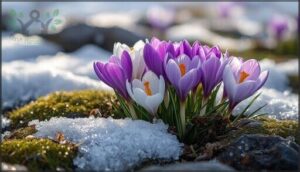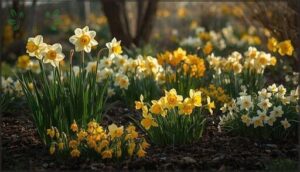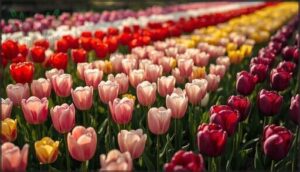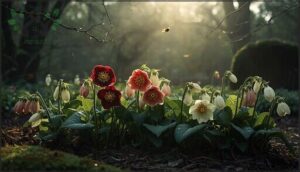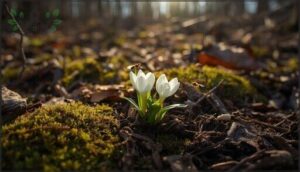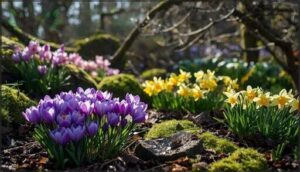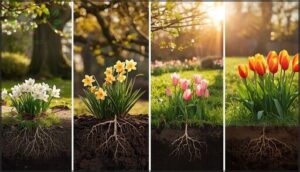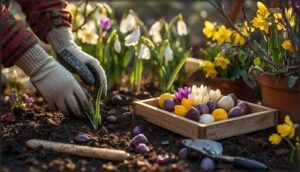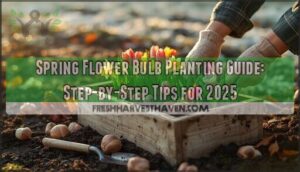This site is supported by our readers. We may earn a commission, at no cost to you, if you purchase through links.
The first crocus pushing through late-winter snow signals more than spring’s arrival—it marks the start of a garden season that can bloom for months if you choose the right plants.
While most gardeners wait for April’s traditional flowers, dozens of species and cultivars thrive in March or even February, offering color when your yard needs it most. Crocuses, daffodils, and hellebores lead the charge, but lesser-known natives like bloodroot and trillium deliver equally stunning displays.
Understanding which early bloomers match your conditions—from sun-loving tulips to shade-tolerant woodland species—lets you design a garden that transitions naturally from winter dormancy to full spring glory.
Table Of Contents
- Key Takeaways
- Popular Early Spring Blooming Flowers
- Perennial Spring Flowers for Your Garden
- Early Blooming Shrubs and Ground Covers
- Growing Conditions for Early Spring Flowers
- Tips for Planting and Caring for Early Bloomers
- Frequently Asked Questions (FAQs)
- What are the earliest blooming spring flowers?
- What flower blooms the earliest?
- What flowers bloom in February and March?
- What is the famous flower that blooms in the beginning of spring?
- What flower blooms the earliest in spring?
- What are the earliest blooming bulbs in spring?
- What wildflowers bloom in early spring?
- What spring flowers attract beneficial pollinators early?
- Which early spring blooms are deer-resistant?
- How to prevent pests from damaging spring flowers?
- Conclusion
Key Takeaways
- You can start your garden’s color show weeks before April by planting early bloomers like crocuses, daffodils, and hellebores that handle cold snaps and push through late-winter snow.
- Matching plants to your site conditions—sun-loving tulips for bright spots, shade-tolerant bloodroot and trillium for woodland areas—creates a garden that transitions naturally from winter dormancy to full spring.
- Most early spring bulbs and perennials naturalize easily, meaning you plant once and they return year after year with minimal care, multiplying on their own in well-drained soil.
- Proper planting depth matters significantly: crocuses need 3-4 inches, tulips and daffodils require 6-8 inches, while hellebores sit just beneath the surface to bloom their best.
Popular Early Spring Blooming Flowers
When winter finally loosens its grip, early spring bloomers are the first to appear, bringing color back to your garden. These hardy plants can handle cold snaps and unpredictable weather that would damage more delicate flowers.
From tiny ground-hugging crocuses to tall, showy tulips, you have plenty of options to choose from for your early spring display.
Crocus Varieties and Features
Crocus are among the earliest spring flowers to greet you each season, often pushing through late-winter snow with blooms in white, yellow, blue, violet, and lilac. These hardy flowering bulbs naturalize beautifully in lawns and rock gardens, multiplying year after year. Their flowers, which are cup-shaped and delicate, close up at night and in rainy weather.
- Species crocus like Crocus tommasinianus bloom in late February to early March
- Flower colors range from pure white to deep purple with striking patterns
- Pest resistance is stronger in “Tommies” due to their bitter corms
- Naturalization happens readily in zones 3–8 with well-drained soil
Daffodils and Their Types
Daffodils offer you amazing variety, with botanists recognizing 40 to 200 species and over 25,000 named cultivars. You’ll find 13 major types classified by the American Daffodil Society, from trumpet daffodils with long cups to small-cupped varieties in bi-color combinations.
Early bloomers like ‘February Gold’ and ‘Ice Follies’ extend your spring display across eight weeks while naturalizing reliably in well-drained soil for decades. They’re also known to be deer and rodent-resistant, making them a practical choice for many gardens.
Tulips and Color Options
Tulips deliver virtually every color you can imagine—red, pink, yellow, white, purple, and even near-black cultivars. Tulip breeding has created over 3,000 registered varieties, with romantic hues dominating market trends in 2025.
You’ll notice color changes as soil pH and temperature affect pigment intensity, while rare colors like true black command premium prices.
Color symbolism makes whites popular for institutional landscapes, and deep purples perfect for cottage gardens.
Hellebores and Shade Tolerance
While bold tulips love the spotlight, hellebores thrive where sunlight barely reaches. These shade-loving plants bloom reliably under tree canopies or in woodland garden settings, offering early spring flowers when your yard needs them most.
- Part shade to full shade works well, with best results in dappled light
- Neutral to alkaline soil pH (6.5–8.0) increases bloom density
- Winter hardiness spans zones 5–9, surviving frigid temperatures
- Pollinator attraction peaks early, supporting bees before other blooms appear
Bloodroot and Native Ephemerals
Emerging in March, bloodroot offers delicate white petals before most native spring ephemerals wake up. You’ll see flowers lasting just one or two days, with each bloom reaching two inches across.
This woodland garden plant benefits early pollinators through myrmecochory—ants disperse seeds while native bees gather pollen.
Habitat preservation protects bloodroot populations, and you can grow pollinator support by including it in your spring blooms collection.
Perennial Spring Flowers for Your Garden
Perennials come back year after year, making them a smart choice for your spring garden. These plants establish strong roots and often spread naturally, filling woodland areas and shaded spots with color.
Let’s look at some standout perennials that bloom early and work well in different garden conditions.
Yellow Trillium and Woodland Species
Yellow trillium brings early spring beauty to your woodland garden, blooming from March to May with delicate yellow-white flowers above marbled leaves. Its bloom timing depends on your local climate conditions.
You’ll find this native ephemeral thrives in partial to full shade with moist, well-drained soil, making it perfect alongside other woodland garden plants like spring beauty and trout lily.
Grecian Windflowers and Anemones
Among the most charming early spring flowers, Grecian windflowers (Anemone blanda) spread daisy-like blooms in blue, pink, white, and bicolors across your garden from April to May.
You’ll want to plant these flowering bulbs 4 inches deep in well-drained soil with full sun to partial shade.
Anemone blanda care is straightforward, and they’re low-toxicity plants that naturalize beautifully, creating expanding clumps year after year.
Virginia Bluebells and Trout Lilies
Virginia bluebells and trout lilies are woodland garden standouts that thrive in early spring before tree canopies shade the forest floor. Both native plants need part to full shade and consistently moist soil, making them perfect for naturalizing in your woodland garden. Here’s what makes these early spring flowers special:
- Virginia bluebells bloom mid-April for about 3 weeks
- Trout lily colonies spread through clonal reproduction
- Both support pollinator support when few flowers exist
- Garden dormancy occurs by early summer
- Habitat conservation protects endangered species like some trout lilies
Bleeding Heart and Dutchman’s Breeches
If you’re looking for charming early spring flowers with unique floral morphology, Bleeding Heart and Dutchman’s Breeches won’t disappoint. Both thrive in part shade woodland garden settings with rich, moist soil. Bleeding Heart (Lamprocapnos spectabilis) displays pink heart-shaped blooms from late April through May, attracting hummingbirds. Dutchman’s Breeches (Dicentra cucullaria) offers white pantaloon-shaped flowers in early to mid-spring.
Understanding their pollination ecology and native habitats helps guarantee successful garden cultivation while supporting the conservation status of these woodland treasures.
Early Blooming Shrubs and Ground Covers
If you want early color that lasts beyond a few weeks, shrubs and ground covers are your best bet. These plants bring structure to your garden while flowering when most other plants are still waking up.
Here are some reliable options that bloom early and spread beauty across your landscape.
Forsythia and Flowering Quince
Forsythia and flowering quince are two of the earliest flowering shrubs for spring, often blooming in late winter before leaves appear. Forsythia produces masses of bright yellow flowers, while flowering quince offers scarlet, pink, or white blossoms.
Both are hardy in zones 4 to 8, attract pollinators when few food sources exist, and work well as hedges or specimen plants.
Dwarf Flowering Almond and Fothergilla
Dwarf Flowering Almond and Fothergilla bring fresh interest to your early spring garden with distinct bloom time patterns. Dwarf Flowering Almond opens its pink or white double flowers in late March, while Fothergilla follows with white bottlebrush blooms in early April.
- Both shrubs adapt to zones 4–9, though Fothergilla prefers soil pH around 5.0
- Pollinator value is high, attracting butterflies and native bees
- Pruning needs are moderate, timing cuts after flowering to protect next year’s buds
Japanese Camellia and Pussy Willow
If you want blooms that push the season’s edge, Japanese Camellia and Pussy Willow deliver. Japanese Camellia opens its rose-like flowers from February through April in zones 7–9, reaching up to 8 feet tall. Pussy Willow catkins appear even earlier, often in late February before leaves emerge, thriving in zones 2–9.
Both plants offer considerable ornamental value and wildlife support when few other resources exist. Japanese Camellia should be planted in part shade with well-drained, acidic soil. Pussy Willow, on the other hand, tolerates wet conditions and full sun, making garden integration flexible for your landscape.
| Feature | Japanese Camellia | Pussy Willow |
|---|---|---|
| Bloom Time | February–April | Late February–early March |
| Height | Up to 8 feet | 6–18 feet |
| Hardiness Zones | 7–9 | 2–9 |
| Ornamental Value | Formal double blooms, evergreen foliage | Fuzzy catkins for cut arrangements |
| Wildlife Support | Attracts pollinators and flower-feeding insects | Provides early nectar for bees |
Japanese Camellia attracts pollinators and flower-feeding insects, while Pussy Willow provides early nectar for bees. Their unique features make them valuable additions to any garden, especially during the early spring months.
Creeping Thyme and Phlox Subulata
Two ground cover plants offer reliable early spring flowers and impressive function. Creeping Thyme blooms in late spring to early summer, spreading up to 18 inches and attracting 15–20 pollinator species daily. Phlox subulata flowers 6 weeks after planting, lasting 4–6 weeks with varieties like ‘Candy Stripe’ and ‘Emerald Blue’.
Both plants require full sun, well-drained soil, and minimal maintenance once established, providing erosion control on slopes.
Spring Heath and Other Low-Growing Options
Spring Heath stands out among ground cover plants for its early spring flowers, blooming from late March to early April with pink or red cylindrical flowers. You’ll find over 100 cultivars, including ‘Springwood Pink’ and ‘Springwood White’, which grow 8–12 inches tall and spread up to 24 inches.
These low-maintenance plants thrive in acidic, well-drained soil, offering erosion control and weed suppression for your spring garden.
Growing Conditions for Early Spring Flowers
Getting your early spring flowers to thrive isn’t complicated, but you’ll need to understand what they need to succeed. Different plants have different preferences for sunlight, soil conditions, and temperature ranges, so matching them to the right spot in your garden makes all the difference.
Let’s look at the key growing conditions that will help your early bloomers put on their best show.
Sunlight and Shade Preferences
Sunlight requirements vary widely among early spring bloomers, affecting bloom intensity and duration. Crocus, daffodils, and tulips need full sun—at least six hours daily—for peak performance. Shade-loving plants like hellebores and bleeding heart thrive in partial shade to deep shade, making them perfect under tree canopies.
Part shade suits primroses and hydrangeas, while light duration influences flowering, with woodland ephemerals responding to longer days and adequate sunlight exposure.
Soil and Moisture Requirements
Healthy soil conditions make all the difference for your early spring bloomers. Most perform best with soil pH between 6.0 and 7.0, where nutrients become readily available. Well-drained soil prevents bulb rot, while organic matter boosts water retention and fertility.
Moisture levels matter too—crocus and daffodils need moderate weekly watering, whereas hellebores prefer consistently moist soil. Proper water management keeps flowers thriving without overwhelming roots.
Planting Zones and Cold Tolerance
Understanding USDA plant hardiness zones helps you choose flowers that survive your coldest winters. Zone 3 experiences temperatures as low as -40°F, while Zone 10 rarely dips below 30°F. Frost-tolerant flowers like crocus and daffodils handle extreme cold, making them reliable in northern climates.
- Crocus and daffodils thrive in Zones 3–8, tolerating subfreezing temperatures down to -30°F
- Hellebores withstand minimums of -20°F across Zones 5–9
- Tulips and hyacinths need pre-chilling for 6–8 weeks in Zones 9–10
- Bloodroot emerges while snow still blankets the ground
Naturalizing Bulbs and Perennials
Naturalizing flower bulbs means letting bulbs and perennials return on their own, multiply naturally, and thrive with minimal intervention for years. Crocus, daffodils, and scilla excel at bulb multiplication, spreading slowly while maintaining ecological balance in woodland garden plants.
Naturalizing bulbs means planting once and letting crocus, daffodils, and scilla return and multiply on their own for years
They support pollinators when other food is scarce and fit sustainable designs. Plant in well-drained soil where you won’t disturb them, and they’ll increase steadily each season.
Tips for Planting and Caring for Early Bloomers
Getting early spring flowers off to a strong start doesn’t require complicated techniques, but a few straightforward practices make all the difference. From knowing how deep to plant your bulbs to choosing the right containers for a burst of early color, these basics set you up for success.
Here’s what you need to focus on to keep your early bloomers healthy and thriving.
Planting Depth and Spacing Guidelines
Getting planting spring bulbs right from the start means paying attention to two simple numbers: how deep and how far apart. These fundamentals shape your spring garden’s success, and small adjustments based on your soil considerations and climate impacts make all the difference.
Here’s your essential guide for mass planting early bloomers:
- Crocus bulbs go 3–4 inches deep with 2–3 inches between each one for cheerful drifts
- Tulips and daffodils need 6–8 inches depth and 4–6 inches bulb spacing for healthy roots
- Hellebores sit just beneath the surface—deep planting reduces blooms
- Creeping thyme and phlox spread best at 8–12 inches apart for full coverage
- Sandy soils require slightly deeper depth adjustments to retain moisture longer
Watering and Fertilizing in Early Spring
Early spring flowers need about 1 inch of water weekly, adjusted for soil drainage and rainfall. Your watering frequency should shift from every 5–7 days to every 3–4 as temperatures climb. Watering timing matters—mornings reduce fungal risks.
For fertilizer types, choose low-nitrogen formulas (1:3:2 ratio) rich in phosphorus. Apply once in early spring following your fertilizing schedule to support blooms without overwhelming roots, keeping spring flower care simple and effective.
Maintenance and Division Techniques
Most early bloomers need division every 3 to 5 years to keep them vigorous. Tool sanitation between cuts prevents disease spread, reducing infection rates by up to 60%.
Spring garden maintenance includes dividing plants when centers die back, usually in early fall for spring bloomers. Each division should have 3–5 buds for strong regrowth rates.
Post-division care means consistent watering and 2–3 inches of mulch, which cuts moisture loss by over 40%.
Container Gardening for Early Spring Color
Container gardening lets you bring early spring flowers right to your porch or patio. Choose pots 6–8 inches deep with drainage holes, and fill them with fresh potting mix—never garden soil—to cut root rot by 25%. Plant violas, primroses, or English daisies in late February or early March, even in zones 5–7, because containers warm up faster than ground beds.
- Move pots indoors during frost to protect delicate blooms and extend color by weeks
- Pair ‘Apricot Twist’ wallflowers with ‘Orange Princess’ tulips for eye-catching spring container combinations
- Group containers outdoors to attract 20% more pollinators and boost flowering success
Frequently Asked Questions (FAQs)
What are the earliest blooming spring flowers?
Like clockwork, snowdrops emerge through snow in January or February, followed by crocuses in February to March, and daffodils from late January through early May, marking winter’s retreat.
What flower blooms the earliest?
Snowdrops (Galanthus nivalis) claim the earliest bloom slot, often flowering in late January through March.
Winter Aconite and Crocus species follow close behind, making these three bulbs your first signs of spring.
What flowers bloom in February and March?
Crocus and snowdrop appear in mid-February, while daffodils, hellebores, and bloodroot follow in late February and March.
Winter aconite and trillium also emerge during these months, offering earliest colors as spring ephemerals awaken.
What is the famous flower that blooms in the beginning of spring?
Tulips claim fame as the iconic early spring bloomers, with their vibrant colors and cultural impact drawing millions to festivals worldwide.
Crocuses and snowdrops also rank among celebrated early bloomers, offering symbolism and beauty through late winter.
What flower blooms the earliest in spring?
When winter’s grip finally loosens, snow crocus often claims first prize, emerging as early as late February or even pushing through lingering snow.
Other early spring bloomers like winter aconite follow close behind, though bloom timing factors and microclimate effects can shift this order.
What are the earliest blooming bulbs in spring?
The earliest flowering bulbs you’ll see are snowdrops, often pushing through snow in late winter. Crocus follows, then winter aconite brings golden blooms that attract early pollinators before most gardens wake up.
What wildflowers bloom in early spring?
You’ll find bloodroot, spring beauties, and trout lilies among the earliest wildflowers, with some appearing as early as February.
These ephemeral wildflowers thrive in woodland settings, offering essential nectar sources for native pollinators.
What spring flowers attract beneficial pollinators early?
Crocus, grape hyacinth, and willow catkins provide critical nectar when few blooms are open. Virginia bluebells and native spring beauties support wild bees.
Pollinator-friendly gardens with diverse native blooms strengthen ecological balance for early-emerging bee populations.
Which early spring blooms are deer-resistant?
You can protect your early spring garden from deer with daffodils, hellebores, and hyacinths—all naturally deer-resistant perennials and bulbs.
Forsythia and flowering quince also offer reliable garden protection against wildlife browsing.
How to prevent pests from damaging spring flowers?
Think of garden pests like uninvited guests—you can discourage them without harsh tactics. Biological barriers, organic deterrents, and integrated management maintain ecological balance.
Combine pest control methods with spring garden maintenance to protect fragrant flowers and pollinators naturally.
Conclusion
The early bird catches the worm—and the early gardener catches the full glory of spring. By selecting spring flowers that bloom early, from bold crocuses to shade-loving hellebores, you’ll transform your yard from barren to beautiful while neighbors still wait for warmer days.
Plant bulbs in fall, match species to your site conditions, and you’ll enjoy weeks of color before traditional April blooms appear. Your reward? A garden that awakens alongside the season itself.


